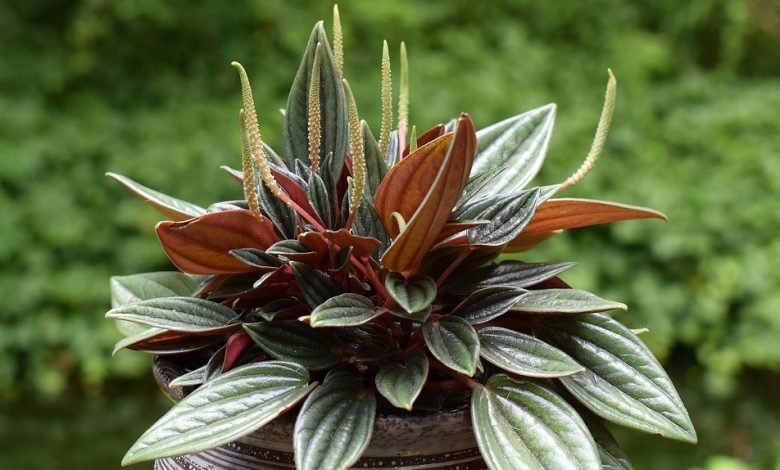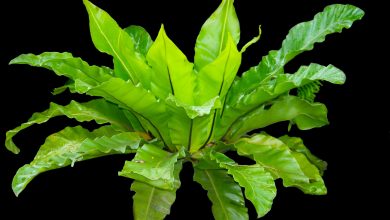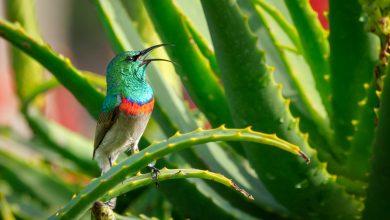Peperomia Plant Care

Peperomia, otherwise known as the radiator plant, is a genus of the Piperaceae family of plants, with over 1,500 known species. Peperomias are more common in South and Central America, but the plants occur in all tropical and subtropical parts of the world. Radiator plants are small, perennial, and epiphytic, preferring to grow on decaying wood.
Peperomia plants differ significantly in appearance. They’re generally compact (rarely growing more than 12 inches tall), have fleshy leaves, and stout stems. Peperomias are good houseplants as they’re easy to maintain, they tolerate different growing conditions, and their small size makes them ideal for small rooms, balconies, and desktops.
Popular peperomia plants include:
- Baby rubber plant (Peperomia obtusifolia)
- Variegated baby rubber plant (Peperomia obtusifolia variegata)
- Trailing jade (Peperomia rotundifolia)
- Watermelon peperomia (Peperomia argyreia)
- Red ripple peperomia (Peperomia caperata)
Radiator plants are simple house plants to care for; the different species will grow in similar conditions. Like all tropical epiphytes, soil and light are essential parts of these plants’ care.
Light
Peperomia plants thrive in bright indirect sunlight. Indoors, east or west-facing windows will provide the required light. If you take the plant outside, place it under shade to protect it from the sun’s direct rays, which will damage its leaves.
Insufficient light will result in leaf drop and discoloration, decelerated growth, and a leggy plant stretching in the direction of the nearest light source. Six to 12 hours under a full-spectrum fluorescent bulb can make up for any light deficiencies in dark areas.
Soil
Peperomia plants are epiphytic, meaning that their roots do not grow in the soil. Instead, they latch unto other plants and survive by collecting nutrients from the air, rain, and debris.
The ideal soil for peperomia is one that’s well-aerated and quick-draining; such sods will permit air and prevent root rot arising from overwatering. A combination of equal parts of perlite and peat moss or regular potting soil and perlite will serve peperomia plants well.
Potting
Grow peperomia plants in pots with holes at the bottom, as the benefits of a quick-draining soil and moderate watering gets mitigated by a container that won’t permit water to drain.
A small sized pot is ideal, as even mature peperomia plants are small (eight to fifteen inches) and prefer to have their roots packed together.
Repotting
Due to their size, radiator plants do not require frequent repotting and can stay in the same pot for years. Still, there are instances when the plant will need a new container, such as when the roots start to grow out of the drain holes or when the soil becomes compacted and begins to hold more water.
Repot the plant into a slightly bigger pot if the roots start to grow out of the drain holes. You can use a similar-sized container if the soil becomes compacted and needs to be changed. The following are the steps to repotting a peperomia:
- Fill the new pot halfway with a well-drained and aerated potting mix, like the one detailed above.
- Carefully withdraw the plant from the container.
- Eliminate as much of the old soil as possible from the roots.
- Set the plant in the new pot and cover the roots with the same soil.
- Water the plant thoroughly until the soil gets saturated, and water flows out of the holes.
Temperature
Tropical house plants, including peperomias, do not enjoy low temperatures. Radiator plants thrive in temperatures between 70 to 80 degrees Fahrenheit. These plants do not enjoy cold drafts, so position them in a place with a relatively constant temperature.
Humidity
Radiator plants, due to their tropical origins, require moderate to high levels of humidity. Varieties with thicker leaves will generally require less humidity. You can use a tray with pebbles and water to increase humidity. Misting will work as well, but ensure that you spray the plant in the morning so that the water can evaporate before nightfall, as water droplets on leaves and stems can cause diseases.
Watering
Radiator plants require moderate amounts of water. The thick leaves of the plants retain water. As such, the effects of underwatering are not so severe and can easily get corrected by giving the plant more water.
Over-watering leads to root rot, a leading cause of most peperomia problems. Correcting the effects of overwatering requires drastic measures like cutting off entire sections of the plant. To prevent over-watering, allow the top half of the soil to dry out before giving the plant more water.

Feeding
Peperomia plants do not require much fertilizer. Drooping or discolored leaves are often signs of poor light or too much water, and not malnutrition. Monthly applications of a regular balanced fertilizer diluted to half strength will meet the plant’s needs and not cause root burn. Feeding the plant in the winter or fall is unnecessary.
Propagation
The thick and succulent nature of Peperomia plants allows for easy propagation. Still, successful propagation is dependent on several factors such as the soil, temperature and light, the parent plant, and the season (spring is the best time to propagate, as new growth will be most vibrant at this time). Leaf and stem cuttings are the primary ways to grow new radiator plants.
Whichever method you chose, ensure that all tools used for propagation are clean (preferably sterile), as fungal diseases can prevent successful propagation.
Leaf Cuttings
The steps to propagate radiator plants by leaf cuttings are detailed below.
- Put one and a half to two inches of soil on the propagation tray.
- Use a knife or scissors to take a healthy leaf cutting from a mature plant, cutting at the end of the petiole (leaf stalk), where it branches off from the stem.
- Place the end of the cutting in rooting powder, to encourage faster root growth.
- Push the end of the cutting into the soil, and gently pat around it so that it stands upright. You can cut off the top half of the leaf if its weight does not allow the cutting to stand upright. Rather than discarding the cut half, dip the cut end in rooting powder and place it upright in the soil.
- Water the soil.
- Cover the cuttings to keep things humid. If a covered propagation tray is unavailable, you can use plastic wrap.
- Position the cutting in a warm place that gets ample indirect sunlight.
- Remove the covering at intervals, to prevent fungal diseases arising from excess humidity.
- You can permanently remove the covering once you observe new growth.
- Wait until several leaves develop before repotting the new peperomia.
Stem Cuttings
Stem cuttings are the ideal way to propagate peperomia species with variegated leaves, as this technique will preserve the leaf variegation better than leaf cutting. The steps to propagate by stem cuttings are similar to leaf cuttings and are as follows:
- Use a clean and sharp knife or scissors to cut a healthy stem with three or more pairs of leaves.
- Take off the leaves closest to the end of the cutting so that a portion of the stem is bare. The roots will grow from the joints of the excised leaves.
- Place the cut end of the stem in rooting powder.
- Place the stem in the soil, patting around it to make it stand upright.
- Follow the remaining steps (five to ten) for propagating with leaf cuttings.
You can also propagate peperomia stem cuttings in water. An advantage of water propagation is that it allows you to observe the root growth. The process is relatively simple and is as follows:
- Remove the leaves closest to the end of the stem.
- Place the stem in water so that only the nodes of the removed leaves are submerged; the stem will be deprived of oxygen otherwise.
- Position the cutting in a warm place that gets ample indirect sunlight.
- Change the water every other day or when it gets cloudy.
- New roots will start growing from the submerged leaf nodes in about three to six weeks.
- Transfer the plant to the soil when two to three new leaves appear, as this is an indication of well-developed roots.
It’s not necessary to use rooting powder for water propagation.

Flowers
Although peperomias are flowering plants, producing yellow to brown spike-like flowers, they’re popular not for their flowers, but their glossy and sometimes colorful leaves.
Pests
Mealybugs, fungus gnats, and mites are the most common peperomia pests. Mealybugs appear as white masses on the lower parts of the leaves and the roots. Peperomias are small and slow-growing, and mealybugs will further stunt the growth of the plant. Use neem oil or insecticidal soap to get rid of mealy bugs.
Fungus gnats are black flies that stay in the soil. The flies do not harm the plant, but their larvae feed on the plant’s root. Covering the top of the potting soil with sand or small quantities of cinnamon powder can control fungus gnats.
Mites are tiny arachnids; their presence can go unnoticed until they cause significant damages like necrotic leaves and stunted growth. Neem oil or pesticide soaps help get rid of mites.
Toxicity
Virtually all peperomias are not toxic; these plants are safe for pets and children. Still, keep pets away from the plant to protect it.



